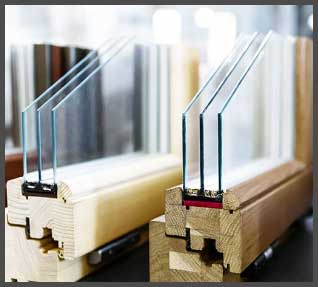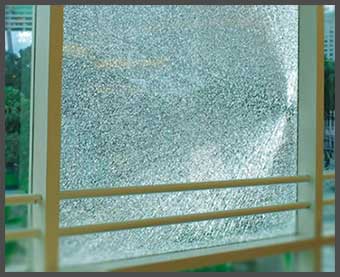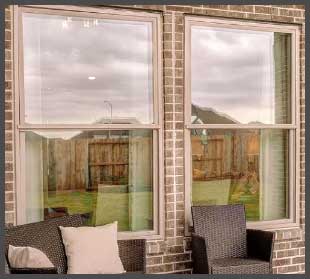When it comes to choosing new windows for your home, two popular options are triple pane and laminated glass. But what’s the difference between these two types of windows?
And how do you decide which is the better choice for your house?
In this comprehensive guide, we’ll break down the pros and cons of triple pane and laminated windows. We’ll look at factors like energy efficiency, noise reduction, security, cost, aesthetics and more.
By the end, you’ll have all the information you need to make an informed decision about triple pane and laminated windows.
A Brief Comparison Table
| Feature | Triple Pane | Laminated Glass |
| Energy Efficiency | Excellent – Multiple layers provide very high insulation value | Good – Can be designed into energy efficient units |
| Noise Reduction | Excellent – Multiple glass layers and air spaces reduce noise transmission | Very Good – PVB interlayer dampens noise |
| Durability | Good – Exterior glass layer is vulnerable if cracked | Excellent – Glass bonded together by interlayer, very impact resistant |
| Security | Fair – No better than single pane against intruders | Excellent – Very difficult to break through |
| UV Ray Blocking | Good – Blocks ~75% of incoming UV rays | Excellent – Blocks over 99% of UV rays |
| Visible Light Transmission | Good – Slight reduction in visible light | Fair – Interlayer can create faint haze |
| Initial Cost | Moderate – Less than laminated glass | High – Laminating process increases costs |
| Long Term Savings | Excellent – Energy savings pay back in 5-10 years | Good – Lower energy bills but higher upfront cost |
What Is Triple Pane Glass?

Triple pane windows have three panes of glass separated by argon or krypton gas filled spaces.
The three glass layers create two insulating “dead air” spaces between them.
This construction gives triple pane windows increased energy efficiency compared to single or double pane windows.
The extra pane of glass provides another layer of insulation to reduce heat transfer in and out of your home.
In winter, the additional pane helps keep heated indoor air inside. In summer, it blocks transfer of heat and solar radiation from the outside. Triple pane windows have very low U-factors, which measures how well a window prevents heat from escaping.
Triple pane glass also provides excellent noise reduction. The three glass layers and two air spaces block more outside noise from entering your home. So these windows are ideal if you live on a busy road or under an airplane flight path.
Overall, the main advantages of triple pane windows are:
- Increased energy efficiency and reduced heating/cooling costs
- Better insulation and ability to maintain comfortable indoor temperatures
- Reduce outside noise transmission
- Resist temperature condensation on the glass
One thing to note is that triple pane windows are quite heavy due to the extra glass layer. Special frames reinforced with metal or fiberglass are required to support their weight.
What Is Laminated Glass?
Laminated glass is constructed by bonding two or more panes of glass together with a plastic interlayer, typically made of polyvinyl butyral (PVB).
The PVB laminate holds the glass layers together, creating a “sandwich” with glass on the outside and plastic in between. Laminated windows may consist of two panes (a double laminated insulating glass unit) or be a single laminated pane.
The main advantage of laminated glass is safety and security. If the glass breaks, the PVB interlayer holds the shards together to prevent injury. Laminated glass is extremely hard to break through, keeping intruders out. It provides protection against debris in storms and reduces UV radiation fading your furniture or floors.
Laminated glass also has sound dampening properties to decrease outside noise. It filters more than 99% of UV rays and blocks over 80% of solar heat coming through the window.
Key benefits of laminated windows:

- Safety – glass shards adhere to interlayer if broken
- Security – very difficult to break glass
- Reduce UV rays from sun
- Noise reduction
- Protection from storm debris and flying glass
One thing laminated glass does not do as well is prevent heat transfer and insulation.
The plastic interlayer has low thermal resistance, so laminated glass alone will not create an energy efficient window.
Key Differences Between Triple Pane And Laminated Windows
- Comparing Energy Efficiency
When it comes to energy efficiency and insulation, triple pane windows are the clear winner.
The extra glass pane and air/gas space provide excellent thermal insulation. Triple pane windows can achieve U-factors as low as 0.20, compared to about 0.35 for the best double pane windows.
Laminated glass by itself does not add much insulating value – just a single layer of plastic interlayer. Typical U-factors for laminated glass alone range from 0.50 to 1.00.
However, laminated glass can be incorporated into an insulating glass (IG) sealed unit with an air gap between two panes. For example, combining a laminated double pane interior with a solid 3rd pane exterior creates an energy efficient triple pane IG unit.
So while triple pane is naturally more insulative, laminated glass can be designed into energy efficient window units as well.
- Noise Reduction: How Do They Compare?
Both triple pane and laminated glass can significantly reduce noise transmission from outside your home. But which option blocks more noise?
With its three glass layers and two air spaces, triple pane glass naturally performs very well at sound dampening. Every additional boundary the sound waves have to pass through cuts down more noise.
Most triple pane windows achieve an STC (sound transmission class) rating of 35-39. This means they reduce perceived loudness of traffic, aircraft, and other exterior noise by over 75%.
Laminated glass with a PVB interlayer also does a great job blocking sound transmission, achieving an STC rating of 33-38. The damping effect of the plastic layer is very effective at noise reduction.
So in summary, triple pane and laminated glass offer comparable noise blocking ability. Both can effectively reduce outside noise by at least 75% when properly installed and sealed.
If sound insulation is your main goal, either of these options will satisfy. But triple pane may provide slightly greater sound dampening due to the extra glass layer.
- Strength and Durability
When it comes to durability and resilience, laminated glass has a clear advantage over triple pane.
The PVB interlayer in laminated glass holds the pane together even when broken. This prevents shards from falling out and causing injury. Laminated glass is extremely hard to break through from the outside when installed properly in a window frame.
In contrast, the individual glass sheets in triple pane windows remain separate. If the exterior pane cracks under force or impact, the broken glass fragments could fall out. The remaining panes may eventually fail without the protection of the outermost layer.
However, it is possible to combine both technologies – triple pane glass with laminated layers. For example, you could have an exterior laminated double pane layer along with a solid interior pane.
This provides the strength and security of laminated glass, along with the insulation of triple glazing. The cost will be more than either individually, but it maximizes durability and efficiency in one unit.
For strict glass strength, laminated is the winner. But a hybrid triple pane + laminated design can provide reinforced protection too.
- Aesthetics
Aesthetically, there is little perceptible difference between triple pane and laminated glass windows when installed in a home.
From the exterior, both window types have a similar modern, sleek look. You are very unlikely to notice the construction differences from curbside appeal alone.
On the inside, laminated and triple pane glass also appear virtually identical. The thin plastic interlayer in laminated units is not visible or detracting.
One difference is that laminated glass often has slightly less visible light transmission. The PVB interlayer can create a faint haze or blur, which some may find aesthetically unappealing.
But overall, most homeowners find the look of triple pane and laminated windows attractive and modern. Neither stands out as being more or less visually appealing. Focus instead on window frames and architectural style rather than the glass type.
- Security
Safety and security are two major considerations for many homeowners. If these are important to you, laminated glass is the clear winner.
The bonded layers of laminated glass make it extremely difficult to break through. Even cracked laminated glass remains firmly in the frame. This prevents easy entry by intruders.
Triple pane glass breaks similarly to single pane when impacted. The exterior pane will crack and shatter, leaving the interior panes exposed and vulnerable. Triple pane offers no more security than single pane from forced entry.
However, triple pane windows do provide better security against heat loss at night. The improved insulation keeps your home warmer if a single pane breaks unexpectedly. With laminated glass, a broken exterior pane severely compromises insulating capacity.
So in summary:
- Laminated glass is safer against break-ins and wind/storm damage
- Triple pane remains more insulating if an exterior pane breaks unexpectedly
If security is more important than efficiency for you, choose laminated window units for peace of mind.
- Cost Comparison
In terms of upfront purchase price, laminated windows are generally a bit more expensive than triple pane.
Laminated glass requires a multi-step manufacturing process to bond the layers and then seal them into an insulating glass unit. The PVB interlayer also adds more material cost.
Triple pane windows simply add an additional pane of glass with a sealed air gap. The extra glass does add more cost than double pane, but less than bonding treatments.
However, the energy efficiency of triple pane windows means lower heating and cooling costs in the long run. Energy bill savings typically pay back the higher initial price over time.
Here are some typical price ranges for basic triple and laminated glass units:
- Triple pane windows: $45 – $70 per square foot installed
- Laminated windows: $55 – $75 per square foot installed
So while laminated glass may cost more upfront, don’t forget to factor long-term energy savings into the decision. Triple pane windows quickly pay for themselves through insulation benefits.
Which Blocks More UV Rays?

Excess UV radiation from sunlight can damage furnishings and cause fading over time.
So which window blocks more UV – triple pane or laminated?
The answer is laminated glass. The PVB interlayer in laminated windows filters over 99% of UV rays.
This provides excellent protection for your interior furnishings and floors.
Standard triple pane glass blocks around 75% of UV light. Adding a laminated layer to create a triple pane IG unit improves UV filtering to over 95%.
But for maximum UV protection, stand-alone laminated glass is the best choice. The bonded plastic interlayer simply filters out more of the damaging radiation.
Making A Decision
So when comparing triple pane vs. laminated windows, how do you decide which is right for your home?
Here are a few rules of thumb:
- If energy efficiency and lower energy bills are the priority, choose triple pane windows. Nothing beats the insulation of three glass layers.
- For maximum safety, security and durability, opt for laminated glass windows. The bonded layers prevent shattering injuries.
- To balance benefits, consider combining the technologies (e.g. triple pane IG unit with laminated layers).
- For sound insulation, either triple or laminated will work well. Triple pane may provide slightly better noise reduction.
- If blocking UV rays is important, laminated glass filters out more radiation.
Also consider your climate zone – triple pane makes more sense in extreme cold or hot weather regions. Budget can be a factor too, as laminated glass typically comes at a higher upfront cost.
Most experts recommend triple pane for colder regions like the Northeast and laminated panes for hurricane-prone coastal areas. But assess your needs to make the best decision.
And remember, newer windows save energy and improve your home’s comfort and security. So either of these options is a good investment over outdated single pane windows!
Frequently Asked Questions (FAQ)
Some potential downsides of triple pane windows include:
Higher upfront cost than double pane
Heavier weight requiring reinforced window frames
Slightly less visible light transmission
Not as durable as laminated glass if broken
Difficult to repair or replace broken exterior pane
In most climates, upgrading from single or double pane to triple pane windows makes sense for the energy savings. Lower heating and cooling bills typically pay back the investment in less than 10 years. If your windows are old and inefficient, triple pane brings better insulation and comfort.
Triple pane windows can make a significant difference in energy efficiency compared to single or double pane. The extra glass layer and trapped gas/air reduce heat transfer through the window by 25-50%. This can reduce energy bills by 10-15% annually.
Triple glazing costs more upfront but pays back through lower energy bills. With energy savings of 10-15% per year, triple pane windows can pay back their higher price in as little as 5-10 years. If you live in a colder climate and want the best insulation, triple pane windows are worth the investment.
The Bottom Line
Triple pane and laminated windows both have unique strengths and benefits. Key differences include:
- Triple pane offers better insulation and energy efficiency.
- Laminated glass provides superior durability, security and safety.
- Triple pane insulates slightly better against noise.
- Laminated blocks more UV and looks clearer.
- Triple pane costs less upfront but saves more long-term.
For most homes, triple pane makes sense if energy savings are the priority. But laminated is ideal for hurricane regions or maximizing security. Combining both technologies gives you the best of both worlds.
Hopefully, this comparison has helped you understand the pros and cons of triple pane vs. laminated windows. Whichever you choose, new high performance windows make a worthwhile upgrade over old single pane models!
